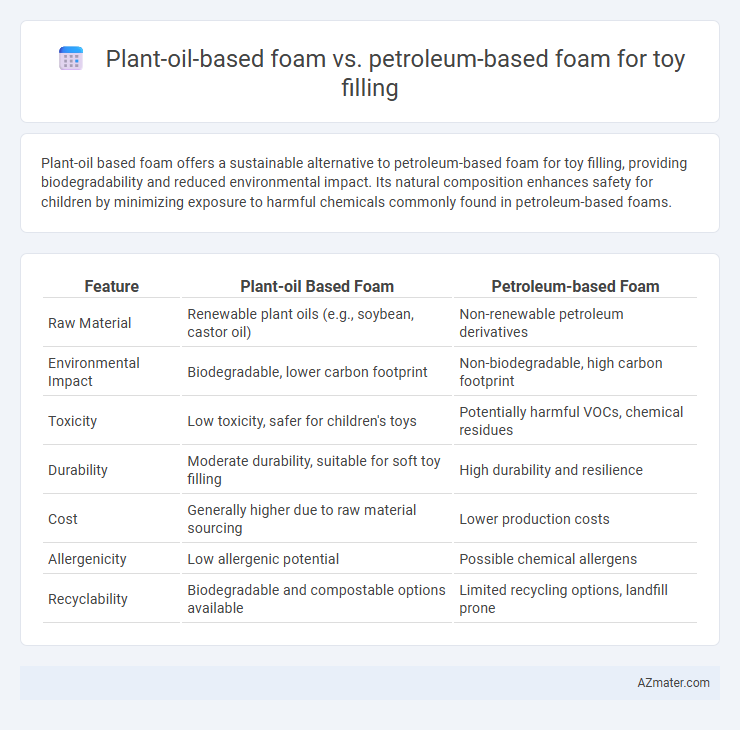Plant-oil based foam offers a sustainable alternative to petroleum-based foam for toy filling, providing biodegradability and reduced environmental impact. Its natural composition enhances safety for children by minimizing exposure to harmful chemicals commonly found in petroleum-based foams.
Table of Comparison
| Feature | Plant-oil Based Foam | Petroleum-based Foam |
|---|---|---|
| Raw Material | Renewable plant oils (e.g., soybean, castor oil) | Non-renewable petroleum derivatives |
| Environmental Impact | Biodegradable, lower carbon footprint | Non-biodegradable, high carbon footprint |
| Toxicity | Low toxicity, safer for children's toys | Potentially harmful VOCs, chemical residues |
| Durability | Moderate durability, suitable for soft toy filling | High durability and resilience |
| Cost | Generally higher due to raw material sourcing | Lower production costs |
| Allergenicity | Low allergenic potential | Possible chemical allergens |
| Recyclability | Biodegradable and compostable options available | Limited recycling options, landfill prone |
Introduction to Toy Filling Materials
Plant-oil based foam for toy filling offers a sustainable and biodegradable alternative to traditional petroleum-based foam, reducing environmental impact and reliance on fossil fuels. These biobased foams often provide comparable softness, durability, and resilience, making them suitable for stuffing plush toys and cushions. Innovations in plant-oil formulations enhance their performance characteristics while promoting eco-friendly manufacturing practices in the toy industry.
Overview of Plant-Oil Based Foams
Plant-oil based foams are derived from renewable resources such as soybean, castor, or palm oil, offering an environmentally friendly alternative to petroleum-based foams commonly used in toy fillings. These bio-based foams exhibit comparable cushioning, durability, and safety standards while significantly reducing carbon footprint and reliance on fossil fuels. Advances in formulation techniques enhance the biodegradability and non-toxicity of plant-oil based foams, making them ideal for sustainable toy manufacturing.
Understanding Petroleum-Based Foams
Petroleum-based foams, derived from non-renewable fossil fuels such as crude oil and natural gas, are widely used for toy filling due to their durability, lightweight nature, and cost-effectiveness. These foams, typically made from polyurethane or polystyrene, offer excellent cushioning and resilience, but their production contributes to environmental pollution and resource depletion. Understanding the chemical composition and environmental impact of petroleum-based foams highlights the growing need for sustainable alternatives like plant-oil based foams in the toy industry.
Environmental Impact Comparison
Plant-oil based foam for toy filling offers a significant environmental advantage over petroleum-based foam by reducing reliance on fossil fuels and lowering greenhouse gas emissions during production. Biodegradability and non-toxic composition in plant-oil foams contribute to less environmental pollution and safer disposal compared to petroleum-based foams, which persist in landfills and release harmful chemicals. The renewable nature of plant oils supports sustainable agriculture cycles, minimizing carbon footprint and promoting eco-friendly manufacturing in the toy industry.
Health and Safety Considerations
Plant-oil based foam for toy filling offers enhanced health and safety benefits due to its reduced release of volatile organic compounds (VOCs) and absence of toxic chemicals commonly found in petroleum-based foams. This biodegradable alternative minimizes allergic reactions and exposure to harmful substances, making it safer for children's sensitive skin and respiratory systems. Compared to petroleum-based foam, plant-oil foams are less flammable and emit fewer hazardous fumes during manufacturing and disposal, supporting safer indoor environments and ecological health.
Performance and Durability Analysis
Plant-oil based foam for toy filling exhibits enhanced biodegradability and reduced environmental impact compared to petroleum-based foam, while maintaining comparable cushioning and resilience. Performance tests show that plant-oil foam provides sufficient shock absorption and shape retention over extended use, aligning with safety standards for children's products. Durability analysis reveals that petroleum-based foam often resists moisture and compression better, but advancements in biofoam formulations are closing this gap, offering sustainable alternatives without compromising longevity.
Cost Effectiveness and Market Trends
Plant-oil based foam for toy filling offers a cost-effective alternative to petroleum-based foam due to lower raw material volatility and increasing consumer demand for sustainable products. Market trends indicate a rising preference for bio-based foams driven by eco-conscious shoppers and regulatory pressures, causing manufacturers to adopt plant-derived materials despite slightly higher initial costs. Continuous innovation in plant-oil foam formulations is closing the price gap, making it a competitive choice in the toy industry focused on cost efficiency and environmental responsibility.
Biodegradability and End-of-Life Disposal
Plant-oil based foam for toy filling offers superior biodegradability compared to petroleum-based foam, breaking down more efficiently in natural environments and reducing landfill burden. End-of-life disposal of plant-oil foam typically involves composting or aerobic degradation, minimizing toxic residues and environmental impact. In contrast, petroleum-based foam tends to persist for decades, contributing to microplastic pollution and complicating recycling processes.
Consumer Preferences and Industry Adoption
Plant-oil based foam for toy filling attracts consumers prioritizing environmental sustainability and non-toxic materials, reflecting increased demand for eco-friendly products. Industry adoption of plant-oil foams is rising due to regulatory pressures, biodegradability, and alignment with corporate social responsibility goals, despite higher production costs compared to petroleum-based foam. Petroleum-based foam remains prevalent due to its cost-effectiveness and established manufacturing processes, but concerns over environmental impact and chemical exposure are gradually shifting market preference toward plant-oil alternatives.
Future Innovations in Foam Alternatives
Plant-oil based foam for toy filling offers enhanced biodegradability and reduced carbon footprint compared to traditional petroleum-based foam, aligning with global sustainability goals. Innovations focus on improving the durability and softness of bio-based foams through advanced polymer blends and enzymatic processes, enabling performance parity with synthetic counterparts. Emerging research explores nanocellulose reinforcement and microbial fermentation to create fully compostable, non-toxic foam alternatives suitable for safe and eco-friendly toy manufacturing.

Infographic: Plant-oil based foam vs Petroleum-based foam for Toy filling
 azmater.com
azmater.com